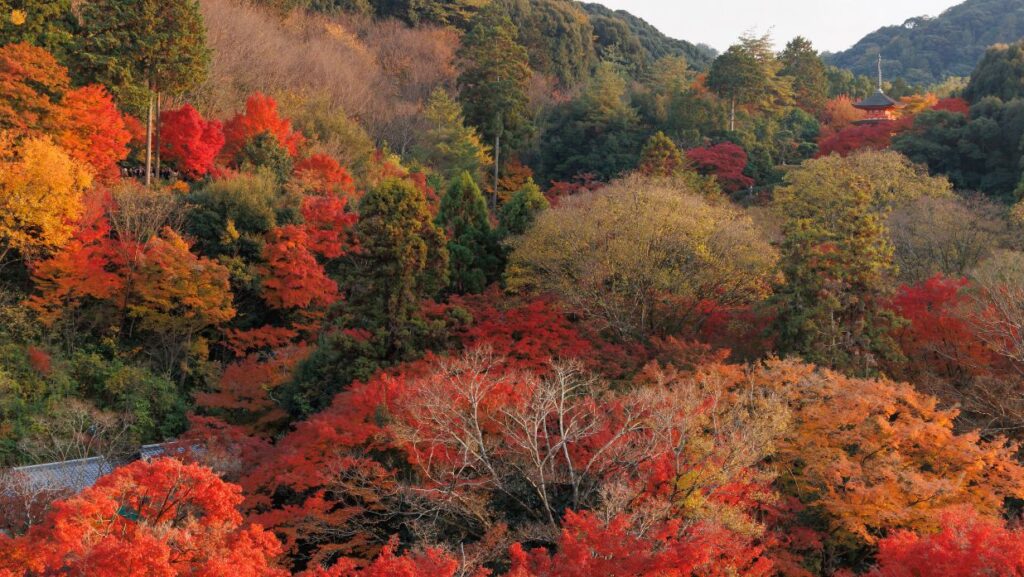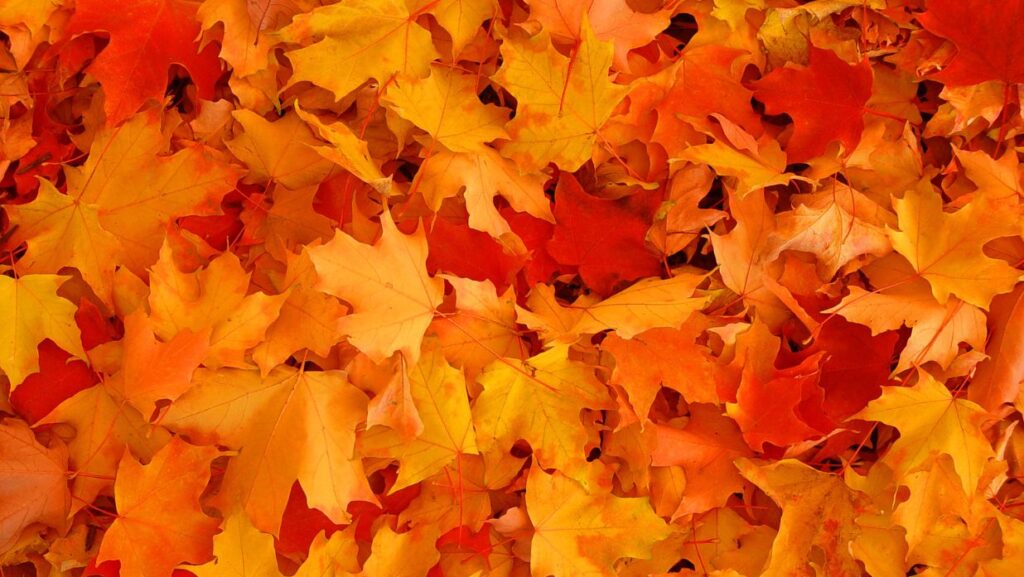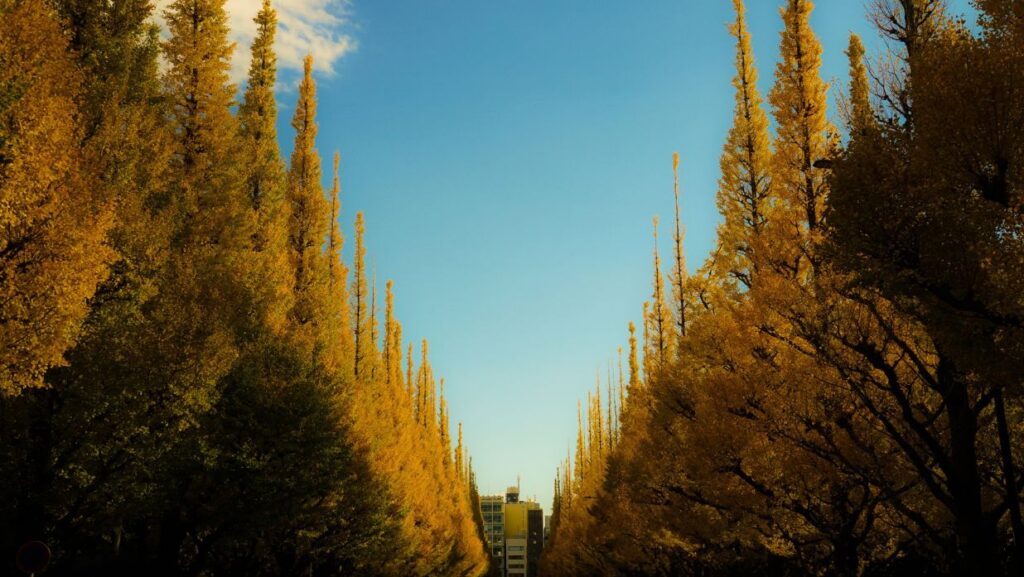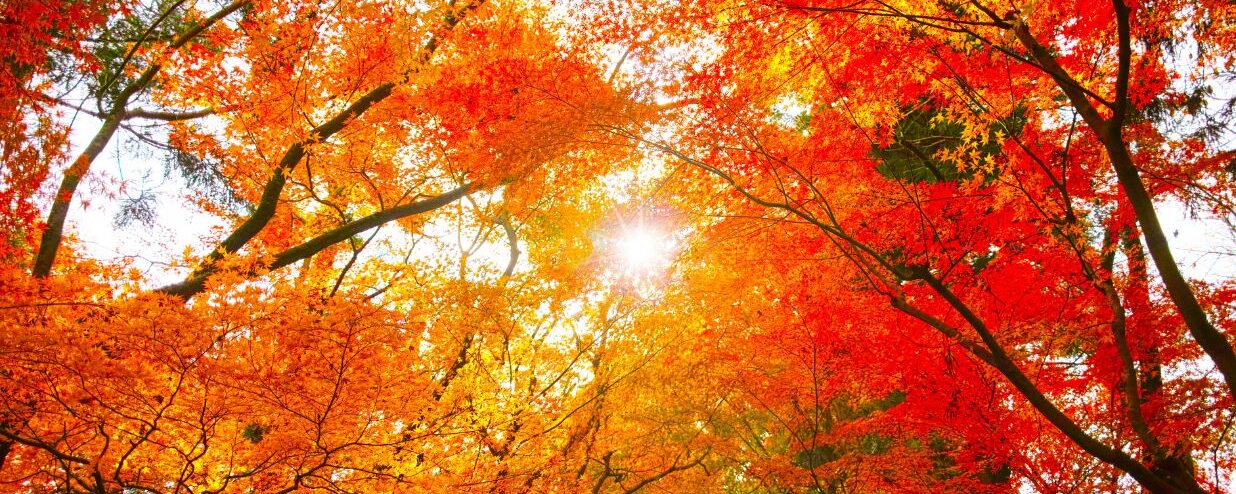If you’re planning on visiting Japan, you should make the trip twice! Once in the spring to experience the cherry blossoms, and again in autumn to witness the beautiful sight of the tree leaves turning red (momiji)!
While cherry blossoms symbolize new life and fresh beginnings, momiji, written as 紅葉, marks the start of the year’s transition toward winter. Despite its association with endings, autumn in Japan is nothing short of stunning. During this season, the natural landscape bursts into fiery shades of red, yellow, orange, and brown.
Interestingly, the kanji 紅葉 can be read in two ways: momiji and kouyou. Although they share the same characters, the words describe slightly different things. Momiji specifically refers to red maple leaves, while kouyou describes the overall process of leaves changing color from green to red.
In this guide, we’ll explore momiji, the different types of autumn colors in Japan, and everything you need to know to make the most of your fall visit.
What Does Momiji Mean?
Momiji refers to Japanese maple leaves that turn vibrant red (and sometimes orange or yellow) in autumn, symbolizing the beauty of Japan’s fall season.
The word momiji actually comes from the old Japanese verb “momizu, ”a term no longer in use, which means “(a leaf) changes color in autumn.” The Japanese word momiji consists of two kanji characters: 紅 and 葉. The first, 紅, means “red” or “crimson” and carries a nuance of deep, vivid color, often associated with dyes, autumn leaves, or anything strikingly red. Its radical, 糸 (ito, meaning thread), hints at coloring or dyeing. The second kanji, 葉, means “leaf” and is composed of the grass/plant radical (艹) on top, indicating its connection to plants, with 世 as a phonetic element. Together, 紅葉 literally translates to “red leaf,” capturing the essence of Japan’s autumn foliage
Momiji vs Kouyou

If you have learned some autumn-related Japanese vocabulary, you might have heard of both momiji and kouyou. Interestingly, both are actually written with the same kanji, 紅葉. Why is that?
Essentially, the same kanji can convey slightly different meanings depending on context and pronunciation. In Japanese, many kanji have multiple readings, and 紅葉 (momiji or kouyou) is a perfect example. The difference comes from kun’yomi and on’yomi readings. Momiji is the kun’yomi, or native Japanese reading, used when referring to the specific red maple leaves. Kouyou, on the other hand, is the on’yomi, or Sino-Japanese reading, used when talking about the broader process of leaves changing color. So, even though the kanji are identical, the reading changes depending on context, allowing the language to convey subtle distinctions with the same characters.
So, while both words share the same characters, momiji focuses on the iconic red maples, whereas kouyou encompasses all autumn foliage. Kouyou, or sometimes written as koyo in English, is harder to translate directly into English, as it conveys more of a concept or idea than just a simple word. This distinction is subtle but important for understanding Japanese culture and its deep appreciation for the changing seasons.
Momijigari: What is It?
Now that we understand the difference between koyo and momiji, let’s explore some activities associated with momiji. Autumn is one of Japan’s peak travel seasons, much like spring, when travelers flock to admire cherry blossoms, enjoy picnics under the blooming trees, and participate in hanami. In the fall, people similarly seek out the most stunning and breathtaking views of autumn foliage, visiting parks, temples, and mountains to witness the vibrant reds, oranges, and yellows of momiji at their peak.
The custom of going to visit scenic areas where leaves have turned red is called momijigari (紅葉狩り). This tradition was born during the Heian Era in the Kyoto region’s aristocracy. In this era, the word 狩り, hunting, was used to speak not only about the hunting of deer, but also the picking of fruit. Of course, Japanese nobility did not participate in such activities, but they were great admirers of nature’s beauty. Finally, the aristocracy borrowed the word 狩り and started to use 紅葉狩り to mean “red leaves viewing”, especially around Kyoto’s temples. Trees were planted specifically for this refined autumn hobby of the era’s elite.
Read More: Where to Enjoy Autumn Leaves in Japan
Learn Japanese as you travel around Japan!
When Can I do Momijigari in Japan?
Similar to the fleeting beauty of cherry blossoms, the momiji, or autumn leaf season in Japan, is short but unforgettable. The colors also appear in waves, peaking at different times depending on the region. While autumn in Japan generally spans from September to November, momiji typically begins to appear in the northern regions around late September, gradually moving southward, and reaches its peak in most central and southern areas around mid to late November. This staggered timing makes it possible to chase the autumn colors across the country for weeks.
Typically, leaves start turning red in Hokkaido around September. From the north, the fall leaves (紅葉前線) will gradually reach the south of Japan. All the popular spots (Nikko, Oirase, and Kyoto) release their forecasts. As for the best timing to see momiji, it is usually around one month after the leaves turn red in Hokkaido for the Tohoku region (around October), as well as early November to December in the Kyushu and Kanto regions.
Check out the most up-to-date autumn foliage forecast in Japan here.
Cultural Significance of Momiji
Admiring the beauty of momiji is not a new tradition. For centuries, Japanese poets and writers have celebrated the vibrant autumn leaves as a symbol of the season. Classical poems often use the red leaves to evoke feelings of impermanence, nostalgia, or the fleeting beauty of life. The ukiyo-e artist Utagawa Hiroshige captured this in woodblock prints such as Autumn Colors at Meguro and Momijidani in Hiroshima, depicting brilliant red and orange maple leaves along rivers, temples, and valleys.
Momiji also plays an important role in festivals and seasonal foods. Momiji Matsuri (Maple Festivals), held in places like Miyajima and Nikko, celebrate the peak of autumn foliage with food stalls, performances, and illuminated trees. Meanwhile, momiji manju, sweet, maple-leaf-shaped pastries filled with red bean paste, originated in Miyajima and remain a popular autumn souvenir.
In Japanese philosophy, the turning of momiji leaves symbolizes impermanence (mujou), reminding people to cherish the fleeting beauty of life, much like the brief but spectacular display of autumn foliage.
Different Types of Momiji

Autumn in Japan isn’t just about red leaves. There’s a stunning variety of momiji to admire. The colors, shapes, and textures of the leaves vary depending on the species. Some locations, such as Meiji Jingu Gaien Ginkgo Park, are famous for their uniform rows of ginkgo trees, creating a sculpture-like autumn display. But if you venture outside Tokyo to more mountainous regions, the true beauty of momiji reveals itself in the natural gradients: shifting colors of red, orange, yellow, and green blending together across the horizon.
The term “momiji” is commonly used to describe all maple trees in Japan that turn red during autumn, though some varieties also show yellow or light brown hues. While most people use momiji as a general term, the different species can actually be categorized more precisely. Here are some variations to momiji.
1. Iroha momiji
The Iroha Momiji is perhaps the most iconic Japanese maple, symbolizing autumn across the country. Its botanical name is Acer palmatum, and it is found widely in Western Honshu, from Fukushima down through Shikoku and Kyushu. This relatively small tree typically grows to about 10 meters in height. The leaves are deeply lobed, delicate, star-shaped, and measure around 5 cm across, splitting into three to seven sections.
The name イロハ (iroha) comes from an old Japanese counting method, where the tips of the leaves were used to count syllables: “I, ro, ha, ni, ho, he, to.” In autumn, the leaves turn a striking bright red. Iroha Momiji is often planted in gardens.
2. Oomomiji
Oomomiji, or “big maple,” is known for its large, striking leaves and impressive presence. The leaves can grow up to 10 cm in diameter and feature 5 to 9 lobes with finely serrated edges, often turning red or occasionally orange in autumn. Native to Japan and the Korean Peninsula, it is commonly found in Hokkaido (south of the Chubu region), Honshu (Pacific side south of Aomori Prefecture and the Sea of Japan side west of Fukui Prefecture), Shikoku, and Kyushu.
Oomomiji grows wild in lowlands and along streams in mountainous areas, but it is most common on the Pacific side. It is also widely planted in parks, gardens, and temple or shrine grounds.
3. Iroha Kaede
The Iroha Kaede is another classic maple variety, with “kaede” simply meaning “maple” in Japanese. The leaves resemble those of the Iroha Momiji but are slightly less delicate, giving the tree a fuller, sturdier appearance. During autumn, the foliage turns vibrant shades of red and orange.
Though not as commonly referenced as Iroha Momiji, the Iroha Kaede is a staple in many parks and residential areas, providing a dependable and beautiful display of Japanese autumn colors.
4. Fuu
The Fuu, or fullmoon maple, is less common but equally captivating. Its leaves are rounder and textured, often with three distinct lobes, and they produce spiky, spherical fruit capsules. In the fall, the foliage transforms into fiery reds, yellows, and oranges, creating a dynamic and layered effect.
While botanically related to Liquidambar formosana (Formosan gum), the Fuu is especially striking in mountainous regions where the leaves catch the sunlight and create a glowing mosaic across the landscape.
5. Shidare momiji
Also called the weeping maple, the Shidare Momiji is prized for its graceful, drooping branches. Often planted in gardens or landscaped spaces, this maple combines elegance with a dramatic flair. The lobed, delicate leaves turn deep red in autumn, and some varieties even display variegated hues.
Shidare Momiji is a favorite in Japanese gardens, where its flowing branches frame ponds, bridges, and walkways.
Other Varieties of Autumn Leaves in Japan

While momiji or Japanese maples are the most famous symbol of autumn in Japan, the season’s beauty is far from limited to red leaves. Ginkgo trees, or icho (イチョウ), turn a brilliant golden yellow, lining streets and temple avenues with glowing color, while other species transform into orange shrubs.
1. Ginkgo
Few sights scream Japanese autumn like streets lined with ginkgo trees, or icho. Their fan-shaped leaves turn a brilliant golden yellow, creating a glowing canopy that looks like it’s straight out of a painting. In Tokyo, Meiji Jingu Gaien is particularly famous for its ginkgo avenue, while Kyoto’s city streets also glow with gold in late November.
Just a heads-up: fallen ginkgo leaves can have a strong, pungent smell.
2. Japanese Beech
If you love forest hikes, Japanese beech trees, or buna, are for you. Their broad leaves shift from yellow to orange and reddish-brown, forming layered canopies in the mountains. Top spots include Nikko, Hakusan, and the Japanese Alps, where the forested hillsides glow in autumn light.
3. Zelkova
Zelkova trees, or keyaki, are tall, elegant, and often planted to line streets, parks, and temple grounds. In autumn, their leaves turn a rich mix of yellow, orange, and red, providing a warm, dramatic contrast to the surrounding architecture. Keyaki trees are especially striking along avenues and public squares, where their height and symmetry create natural “autumn corridors.” Because they are widespread across Japan, you don’t need to travel far to see them. ty.
4. Persimmon
Persimmon trees are a charming mix of red and orange leaves with bright orange fruit still hanging in the fall. Found mostly in rural areas and home gardens, these trees are the perfect Instagram shot.
Kaki is also quite a popular autumn flavor in Japan, and is often eaten raw or dried, depending on the type.
5. Japanese Rowan
In northern Japan and mountainous regions, Japanese rowan, or nanakamado, bursts into fiery shades of red, yellow, and orange. Their clusters of red berries add another layer of color, making these trees a favorite among photographers.
What Can I Do During Autumn in Japan?
Autumn is considered one of the best seasons to travel in Japan, so most hotels and ryokans are fully booked (Pro tip: book early!). One of the most popular activities is momijigari, or autumn leaf viewing, where travelers and locals alike flock to scenic spots to admire the vibrant reds, oranges, and yellows of the season. Famous destinations include Kyoto’s temples and gardens, like Tofukuji and Kiyomizu-dera, as well as mountainous regions such as Nikko, Kamikochi, and the Japanese Alps. Even city streets, lined with golden ginkgo trees, create magical urban autumn landscapes, especially in places like Tokyo’s Meiji Jingu Gaien.
Autumn is also a season of festivals and seasonal foods. Momiji Matsuri (Maple Festivals) in Miyajima and Nikko celebrate the peak foliage with illuminated trees, performances, and food stalls. Seasonal treats such as momiji manju, chestnuts, sweet potatoes, and persimmons are widely enjoyed, while traditional kaiseki meals often highlight autumn ingredients.
For those who love the outdoors, autumn is perfect for hiking, exploring rivers and lakes, or simply strolling through nature trails. After a day of leaf-peeping, relaxing in a hot spring (onsen) surrounded by colorful foliage.
Read More: Things to Do During Fall in Tokyo
Conclusion: Enjoy Japan’s Autumn, Travel Like a Local, and Learn Japanese
Japan is a beautiful country to visit any time of year, and what better way to experience it fully than by learning a bit of Japanese to immerse yourself in the culture?
If you want to build confidence and start speaking Japanese, consider joining conversation-focused Japanese lessons at Coto Academy. As a top-rated school with campuses in Tokyo and Yokohama, we offer fun and flexible lessons designed around practical, everyday conversation. You’ll learn Japanese that you can use immediately outside the classroom.
We offer intensive Japanese courses as well as part-time options, so whether you want to immerse yourself fully or fit lessons into a busy schedule, there’s something for you. Start your journey to speaking Japanese confidently today!
Why join Coto Academy?
- Over 60+ different Japanese classes over 18 levels
- Small classroom of only up to 8 students for personalized support
- Professional, native Japanese teachers
Ready to get started? Fill out the form below to contact us!
FAQ
What is momiji?
Momiji refers to Japanese maple leaves that turn vibrant red, orange, or yellow in autumn. It is a symbol of the Japanese fall season and is celebrated for its stunning beauty across temples, gardens, mountains, and city streets.
What is the difference between momiji and kouyou?
Both words are written with the kanji 紅葉, but the meanings differ. Momiji specifically refers to red maple leaves, while kouyou describes the broader phenomenon of leaves changing colors in autumn. Essentially, momiji is a type of kouyou.
When is the best time to see momiji in Japan?
The timing varies depending on the region, generally between late October and early December. In Hokkaido, leaves peak in late October, while central Japan, like Kyoto and Tokyo, sees peak colors in mid to late November. Southern regions, such as Kyushu, often experience peak foliage in late November to early December.
What is momijigari?
Momijigari literally means “autumn leaf hunting.” It is the traditional Japanese practice of visiting scenic spots to admire the changing leaves, similar to hanami in spring. Travelers and locals alike enjoy strolling through parks, gardens, and mountains during peak foliage.
